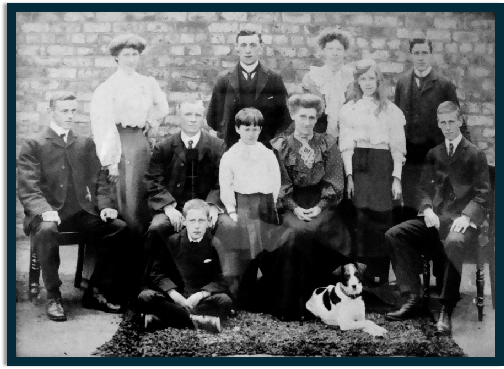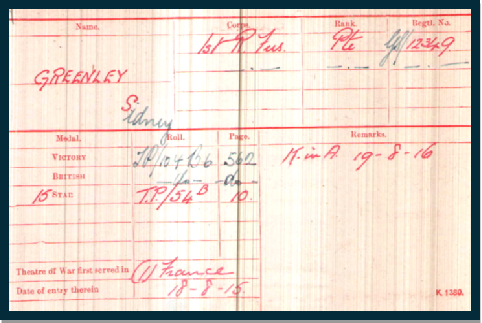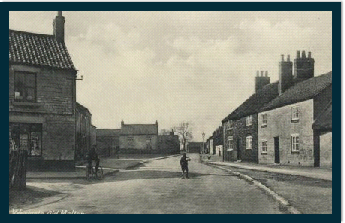Copyright © All rights reserved.



Sidney Greenley
By 1901 Sidney had gone into service and was a footman at 19, Pont Street, Chelsea working for Mr and Mrs Samuelson along with Kate Weller whom he subsequently married. This was a wealthy household boasting a French cook and several other servants.
1901 Census – resident at 19, Pont Street, Chelsea
GREENLEY, Sydney, Servant, Single, M, 19, Footman Domestic, Old Malton, Yorkshire,
WELLER, Kate, Servant, Single, F, 20, House Maid Domestic, Lewis, Suffolk
In the third quarter of 1909 he married Kate Alice Weller in the Paddington area of London, and by 1911 he had risen to butler and moved to Marylebone.
1911 Census – resident at 30 Seymour Buildings Seymour Place, St Marylebone, London
GREENLEY, Sidney, Head, Married 1 year, M, 30, Butler Domestic, Yorks Old Malton,
GREENLEY, Kate Alice, Wife, Married, F, 30, , Sussex Lewes,
Sometime in 1915, Sidney enlisted at Marylebone in the 1st Battalion of Royal Fusiliers (City of London Regiment) in the 17th brigade which was part of the 6th Division. On the 10 September 1914 it had landed at St Nazaire and proceeded to the Western Front, where it remained throughout the war. The 6th Division arrived in time to reinforce the hard-
After the Battle of Loos where the newly-
“On the night of the 29th/30th April the enemy carried out a gas attack on a considerable scale near Wulverghem, on a front of 3,500 yards held by the 3rd and 24th Divisions. The operation was opened by heavy rifle and machine-
Arthur Empey’s eyewitness account of a gas attack reads:
"We had a new man at the periscope, on this afternoon in question; I was sitting on the fire step, cleaning my rifle, when he called out to me: 'There's a sort of greenish, yellow cloud rolling along the ground out in front, it's coming -
Gas travels quietly, so you must not lose any time; you generally have about eighteen or twenty seconds in which to adjust your gas helmet. A gas helmet is made of cloth, treated with chemicals. There are two windows, or glass eyes, in it, through which you can see. Inside there is a rubber-
For a minute, pandemonium reigned in our trench, -
Reinforcements were pouring out of the communication trenches. Our gun's crew was busy mounting the machine gun on the parapet and bringing up extra ammunition from the dugout.
German gas is heavier than air and soon fills the trenches and dugouts, where it has been known to lurk for two or three days, until the air is purified by means of large chemical sprayers. We had to work quickly, as Fritz generally follows the gas with an infantry attack. A company man on our right was too slow in getting on his helmet; he sank to the ground, clutching at his throat, and after a few spasmodic twistings, went West. It was horrible to see him die, but we were powerless to help him. In the corner of a traverse, a little, muddy cur dog, one of the company's pets, was lying dead, with his two paws over his nose.
It's the animals that suffer the most, the horses, mules, cattle, dogs, cats, and rats, they having no helmets to save them. Tommy does not sympathize with rats in a gas attack. At times, gas has been known to travel, with dire results, fifteen miles behind the lines.
A gas, or smoke helmet, as it is called, at the best is a vile-
Our eighteen-
Suddenly, my head seemed to burst from a loud 'crack' in my ear. Then my head began to swim, throat got dry, and a heavy pressure on the lungs warned me that my helmet was leaking. Turning my gun over to No. 2, I changed helmets. The trench started to wind like a snake, and sandbags appeared to be floating in the air. The noise was horrible; I sank onto the fire step, needles seemed to be pricking my flesh, then blackness.
I was awakened by one of my mates removing my smoke helmet. How delicious that cool, fresh air felt in my lungs. A strong wind had arisen and dispersed the gas. They told me that I had been 'out' for three hours; they thought I was dead.
The attack had been repulsed after a hard fight. Twice the Germans had gained a foothold in our trench, but had been driven out by counter-
I examined my first smoke helmet, a bullet had gone through it on the left side, just grazing my ear, the gas had penetrated through the hole made in the cloth. Out of our crew of six, we lost two killed and two wounded. That night we buried all of the dead, excepting those in No Man's Land. In death there is not much distinction, friend and foe are treated alike. After the wind had dispersed the gas, the R. A. M. C. got busy with their chemical sprayers, spraying out the dugouts and low parts of the trenches to dissipate any fumes of the German gas which may have been lurking in same."
After this the next major engagement the 24th Division was involved in was the Battle of Guillemont This was a British assault on the German-
On 18 August a combined British-
Ironically, it was on the day of his death that the Malton Messenger published a short item :
PATRIOTIC OLD MALTON FAMILY
Mr Greenley, 11 Westgate, Old Malton, has five sons “doing their bit”. The eldest George is on a transport, Australian & New Zealand service. Pte Sidney Greenley is in the Royal Fusiliers and has been in France a year, once wounded slightly by shrapnel. Pte Fred Greenley is in the 5th Yorkshires and was recently home on furlough. Pte Harold Greenley is in the 5th Yorkshires, training at Redcar and Pte Edward Greenley in the 3rd Yorkshires training at West Hartlepool. A splendid patriotic record.
Sidney is commemorated on the War Memorials in Old MAlton Priory Church and in the Memorial Hall.



Sidney Greenley was born in Old Malton in the second quarter of 1881 and his birth registered in Malton. He was the second son of Francis and Sarah Ann (nee Bulmer) Greenley who married in the Malton area in the third quarter of 1877. He was baptised in St Mary’s Church, Old Malton on 22nd May 1881
In 1891 the Greenleys were living on Town Street (probably at 107), Old Malton and in the photograph above, probably taken about 1898, Sidney is seated at the left of the picture.
1891 Census –resident in Town Street, Old Malton
GREENLEY, Francis, Head, Married, M, 33, Tailor, Old Malton Yorkshire,
GREENLEY, Sarah A, Wife, Married, F, 30, , Old Malton Yorkshire,
GREENLEY, Emily, Daughter, , F, 13, , Old Malton Yorkshire,
GREENLEY, George H, Son, , M, 11, Scholar, Old Malton Yorkshire,
GREENLEY, Sidney, Son, , M, 9, Scholar, Old Malton Yorkshire,
GREENLEY, Frederick, Son, , M, 7, Scholar, Old Malton Yorkshire,
GREENLEY, Mary E, Daughter, , F, 5, Scholar, Old Malton Yorkshire,
GREENLEY, Harold, Son, , M, 3, , Old Malton Yorkshire,